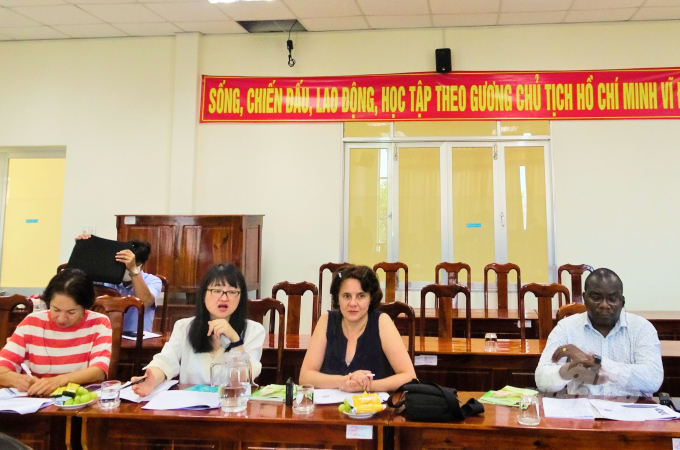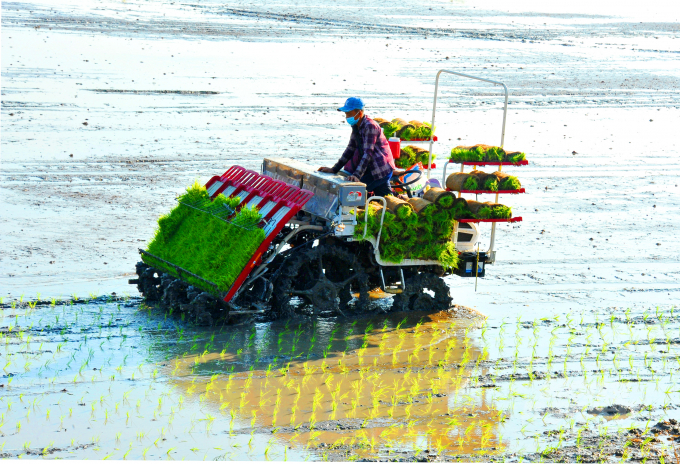June 21, 2025 | 01:59 GMT +7
June 21, 2025 | 01:59 GMT +7
Hotline: 0913.378.918
June 21, 2025 | 01:59 GMT +7
Hotline: 0913.378.918
The World Bank delegation in Vietnam had a meeting on May 23 with the Management Board of the Vietnam Sustainable Agriculture Transformation Project (VnSAT) of An Giang province to conduct a field survey of the project areas in An Phu and Tri Ton districts. Director of Department of Agriculture and Rural Development Nguyen Si Lam and Deputy Director of VnSAT Project Management Board in An Giang province Doan Ngoc Pha co-chaired the meeting with the delegation.
According to evaluation by the VnSAT Project Management Board of An Giang province, the unit has effectively implemented the project's contents since the beginning of 2022. Specifically, the "1 must 5 decrease" training program was organized for 519 farmers (who have previously been trained on "3 decrease, 3 increase") on an area of 1,135 hectares in communes in the project area. Additionally, the unit has organized 3 rotational classes for 75 farmers, 2 classes on rice seed multiplication for 50 farmers, 12 classes on VietGAP-SRP rice production for 297 farmers.
Technical training of "3 reduction, 3 increase" has been provided to 7,535 farmers with a farming area of 11,521 hectares; “1 must 5 decrease” for 15,193 farmers with a farming area of 25,242 hectares; rotationational training for 1,712 farmers/1,884 hectares; by-products utilization training for 1,051 farmers with a farming area of 1,152 hectares; rice seed multiplication training fors 653 farmers with a farming area of 712 hectares; VietGAP-SRP training for nearly 300 farmers.

According to the assessment by the World Bank Delegation, An Giang is one of the provinces in the Mekong Delta that has implemented the VnSAT Project with good results. Photo: Le Hoang Vu.
5 sub-projects in phase 1 and 7 sub-projects in phase 2 have been handed over to farmers' organizations, cooperative groups, cooperatives, local authorities and put into operation, bringing practical results to rice farmers. Regarding 10 approved public investment sub-projects with a total budget of 147.3 billion VND including 9 official sub-projects and 1 contigency sub-project, the VnSAT Project Management Board of An Giang province has signed 11/11 bidding packages; There are 3 packages reaching 100% progress, the remaining 8 packages will be completed before June 30, 2022.
Regarding financial activities, the disbursement rate as of May 23, 2022 has reached 76.2% of the plan. The VnSAT Project Management Board of An Giang province is promoting inspection and stimulating so that by the end of May 2022, the bidding packages for construction and installation will have been completed, and the capital for construction, installation will be disbursed by the end of June 2022.
Mr. Nguyen Si Lam said that during the 5 years of VnSAT project implementation in the province, the project has achieved very high efficiency for rice farmers, and it has helped farmers gain more knowledge in the application of scientific and technical advances in rice farming. Additionally, farmers in cooperative and cooperatives groups are supported by the VnSAT project with optimal infrastructure conditions as well as agricultural machines to help rice farmers grow more efficiently, the productivity and capacity of rice farmers have also increased significantly.

The VnSAT project in An Giang province has achieved great results, helping farmers gain more knowledge in the application of scientific and technical advances in rice farming. Photo: Le Hoang Vu.
Through the evaluation of implemented project models, An Giang's agricultural sector has integrated implementation to build value chains, promote sustainable agriculture towards income and profits for farmers, protect the environment, help farmers deal with the volatile market. However, the project implementation area is still modest compared to the rice farming area in An Giang with a total area of 3 rice crops of over 630,000 hectares per year. If support for the implementation of VnSAT project continues, An Giang province will reciprocate capital to replicate for farmers in the future.
According to the assessment of the World Bank delegation, the VnSAT project is being implemented in 8 provinces and cities in the Mekong Delta including: Kien Giang, An Giang, Hau Giang, Tien Giang, Long An, Dong Thap, Can Tho, Soc Trang and 5 provinces in the Central Highlands: Lam Dong, Dak Lak, Dak Nong, Gia Lai, Kon Tum. An Giang is among the Mekong Delta provinces that has implemented the project with outstanding results. In addition to maintaining the VnSAT project, WB is studying to support one province (possibly An Giang) to implement carbon-balanced production (bringing the carbon index to zero), thereby replicate the model of greenhouse gas emission reduction, environmentally friendly production with adaptation to climate change.
Translated by Nguyen Hai Long
![Turning wind and rain into action: [9] Digitizing hydrometeorological data in response to climate change](https://t.ex-cdn.com/nongnghiepmoitruong.vn/608w/files/news/2025/06/17/z6704423696987_15fd32ffc26d590d204d520c9dac6786-nongnghiep-165943.jpg)
(VAN) Farmers have begun accessing hydrometeorological applications to adjust their cropping schedules, aiming to ensure productivity and adapt to climate change.
![Turning wind and rain into action: [8] Real-time salinity detection and early warning technology](https://t.ex-cdn.com/nongnghiepmoitruong.vn/608w/files/news/2025/06/17/z6704423696987_15fd32ffc26d590d204d520c9dac6786-nongnghiep-151127.jpg)
(VAN) Thanks to the integration of modern hydrological-hydraulic models, remote sensing technologies, and artificial intelligence, the accuracy of hydrological forecasting has significantly improved.
![Turning wind and rain into action: [7] Early disaster warnings help marine farmers minimize losses](https://t.ex-cdn.com/nongnghiepmoitruong.vn/608w/files/news/2025/06/17/z6704423696987_15fd32ffc26d590d204d520c9dac6786-nongnghiep-142942.jpg)
(VAN) In recent years, thanks to early disaster warnings and forecasting, marine farmers in Khanh Hoa province have been able to reduce risks and losses, thereby improving production efficiency.
![Turning wind and rain into action: [6] ‘Four on-the-spot’ disaster management software](https://t.ex-cdn.com/nongnghiepmoitruong.vn/608w/files/news/2025/06/17/e5a48259d6a262fc3bb3-nongnghiep-183800.jpg)
(VAN) By simply activating the scenario on the disaster management software, the relevant authorities immediately know how many households need to be evacuated, where to evacuate them to, and by what means of transportation…
![Turning wind and rain into action: [5] Hue applies modern technology in disaster forecasting](https://t.ex-cdn.com/nongnghiepmoitruong.vn/608w/files/news/2025/06/17/z6704423696987_15fd32ffc26d590d204d520c9dac6786-nongnghiep-093938.jpg)
(VAN) In Hue city, modern technology has recently been applied in meteorological and hydrological forecasting and warning, helping to reduce the damage caused by natural disasters.

(VAN) A cutting-edge farming technique being implemented on an experimental ranch in Arizona's Sonoran Desert has already saved a billion gallons of water over five years, according to Civil Eats.

(VAN) Poultry and pig production and the environment can be boosted through enhanced water technology, according to new research.